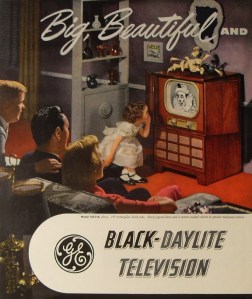
My first memory of television was this big box with a small picture that sat up on a big table. I would watch Ding Dong School with Miss Frances (Dr. Frances Horwich) and The Little Rascals on it. May parents would sometimes watch in the evenings but generally listen to the radio instead. Shows like Gun Smoke and Ozzie and Harriet were still on the radio. This was in the 1950s. For a while we could only get two stations as there was not CBS affiliate in Cleveland until 1956.
After we move to a new house in the same area we got a much newer (but not bran new) TV and my parents would watch more in the evenings. Shows like Burns and Allen, The Big Picture, Death Valley Days, Playhouse 90, Ed Sullivan, Leave it to Beaver, Kraft Television Theater. And the News shows like Huntley-Brinkley Report. Late sitcoms like The Dick Van Dyke Show.
I would get to watch Roy Rogers and The Cisco Kid and The Mickey Mouse Club and Howdy Doody as well as local kiddie shows. I grew out of these fairly quickly. I remember in the summer I could stay up with my parents and watch some of Jack Parr sometimes. A new TV in 1956 cost around 200 dollars. That's 1700 bucks in today's money. TV sets were expensive so people would have only one and treated it with care.
And here is my point, if there is one. Television was more intelligent and educational back in the 1950s and early 1960s because only those with the kind of jobs that required an advanced education could afford to have one. Only 60 percent of the homes had a television in the middle 1950s and by 1958 75 percent had them. There were only 3 networks and unless you live outside of a major metropolitan area, you generally could only pick up 2 stations at most. Even with a good antenna. So the networks programmed to this demographic.
By the late 1960s everyone had at least one television and cable TV was bringing signals to those who would be to far from a metro area to receive them themselves. And the networks changed their programming accordingly. Gone or going away were the High Brow intellectual programs in favor of those appealing to a more general mass market. And TV prices also began to drop with the Japan imports. Even color television became affordable.
With cable and then satellite TV competing for viewership along with video tape and then DVD this competition has become even more fierce. So sure people like Beck and his ilk would never have gotten on TV in the 50s and 60s or even early 70s. But then never would Mad men or Dancing with the Stars or All news channels either.
1 comment:
CM - some of your readership (me, for instance) is not young, and not getting younger.
Please use a larger font.
Post a Comment